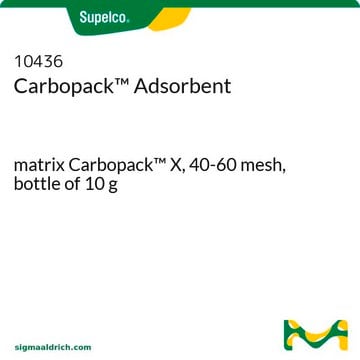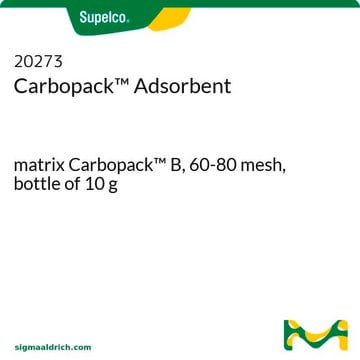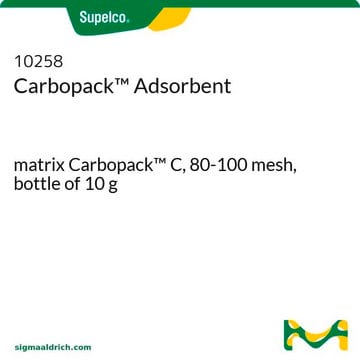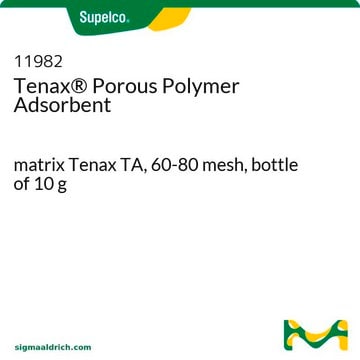추천 제품
product name
Carbopack™ Adsorbent, matrix Carbopack™ X, 60-80 mesh, bottle of 10 g
제품 라인
Carbopack™
형태
granular
포장
bottle of 10 g
기술
LPLC: suitable
표면적
~240 m2/g
기질
Carbopack™ X
기질 활성군
carbon
입자 크기
60-80 mesh
공극 크기
~0.62 cm3/g mesoporosity
~0 cm3/g macroporosity
~0 cm3/g microporosity
~100 Å pore diameter
density
~0.44 g/mL (free fall density)
분리 기술
reversed phase
유사한 제품을 찾으십니까? 방문 제품 비교 안내
일반 설명
Carbotrap®/Carbopack™ adsorbent can withstand high bake-out temperature without losing the mechanical and chemical integrity. It has a high affinity for isoprene and does not retain significant amounts of water. Furthermore it has a tendency to pulverize if it is packed too tightly.
A graphitized carbon black (GCB) can be non-porous or porous. The graphitization process results in a highly pure surface with great adsorption and desorption (if required) properties. Surface interactions depend solely on dispersion (London) forces. These particles are:
Generally, GCB adsorbents offer weaker relative adsorptive strength compared to carbon molecular sieve (CMS) adsorbents, and similar relative adsorptive strength compared to spherical graphitized polymer carbon (SGPC) adsorbents. Our Carbopack products are a type of GCB adsorbent.
For more information about any of our specialty carbon adsorbents, please visit sigma-aldrich.com/carbon
- Granular
- Friable
- Used for molecules with an analyte size relative to C3-C20+ n-alkanes
- Hydrophobic (can be used in high humidity environments)
Generally, GCB adsorbents offer weaker relative adsorptive strength compared to carbon molecular sieve (CMS) adsorbents, and similar relative adsorptive strength compared to spherical graphitized polymer carbon (SGPC) adsorbents. Our Carbopack products are a type of GCB adsorbent.
- Particles are 40 mesh and smaller
- Use 40/60 mesh to prevent channeling (if observed with a 20/40 mesh Carbotrap® adsorbent)
- Use smaller mesh (60/80, 80/100, etc.) for all other applications
- Use the smallest particle size available as long as the application can handle the pressure drop
For more information about any of our specialty carbon adsorbents, please visit sigma-aldrich.com/carbon
애플리케이션
Carbotrap X has a very high specific surface area and was used for the recovery of low boiling hydrocarbons like 1,3-butadiene and isoprene.
법적 정보
Carbopack is a trademark of Merck KGaA, Darmstadt, Germany
Carbotrap is a registered trademark of Merck KGaA, Darmstadt, Germany
Storage Class Code
11 - Combustible Solids
WGK
nwg
Flash Point (°F)
Not applicable
Flash Point (°C)
Not applicable
개인 보호 장비
Eyeshields, Gloves, type P3 (EN 143) respirator cartridges
Choose from one of the most recent versions:
시험 성적서(COA)
Lot/Batch Number
Sorry, we don't have COAs for this product available online at this time.
If you need assistance, please contact 고객 지원 부서
이미 열람한 고객
Stability of reactive low boiling hydrocarbons on carbon based adsorbents typically used for adsorptive enrichment and thermal desorption.
Dettmer K, et al.
Fresenius Journal of Analytical Chemistry, 366 (1), 70-78 (2000)
Comparison of Tenax TA and Carbotrap for sampling and analysis of volatile organic compounds in air.
Rothweiler H, et al.
Atmospheric Environment, 25 (2), 231-235 (1991)
Li-Ming Yuan et al.
Analytical chemistry, 78(18), 6384-6390 (2006-09-15)
Single-walled carbon nanotubes (SWNTs) have high surface area, high adsorption ability, and nanoscale interactions. In this study, capillary columns including SWNTs, ionic liquid (IL), and IL + SWNTs for GC were prepared. The separation results showed that SWNTs possessed a
S A Heberle et al.
Analytical chemistry, 72(4), 840-845 (2000-03-04)
This paper describes a procedure for simultaneous enrichment, separation, and quantification of acetanilide herbicides and their major ionic oxanilic acid (OXA) and ethanesulfonic acid (ESA) metabolites in groundwater and surface water using Carbopack B as a solid-phase extraction (SPE) material.
Bikram Subedi et al.
Bulletin of environmental contamination and toxicology, 92(4), 460-465 (2013-12-10)
A selective pressurized liquid extraction technique (SPLE) was developed for the analysis of polychlorodibenzo-p-dioxins, polychlorodibenzofurans (PCDD/Fs) and dioxin-like polychlorobiphenyls (dl-PCBs) in clam and crab tissue. The SPLE incorporated multiple cleanup adsorbents (alumina, florisil, silica gel, celite, and carbopack) within the
문서
Synthetic CMS carbons offer tailored adsorbents for specific applications.
자사의 과학자팀은 생명 과학, 재료 과학, 화학 합성, 크로마토그래피, 분석 및 기타 많은 영역을 포함한 모든 과학 분야에 경험이 있습니다..
고객지원팀으로 연락바랍니다.







